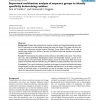17 search results - page 3 / 4 » apTreeshape: statistical analysis of phylogenetic tree shape |
BMCBI
2006
13 years 5 months ago
2006
Background: Multiple sequence alignment is the foundation of many important applications in bioinformatics that aim at detecting functionally important regions, predicting protein...
BMCBI
2007
13 years 5 months ago
2007
Background: Proteins that evolve from a common ancestor can change functionality over time, and it is important to be able identify residues that cause this change. In this paper ...
ALMOB
2008
13 years 5 months ago
2008
The increasing throughput of sequencing raises growing needs for methods of sequence analysis and comparison on a genomic scale, notably, in connection with phylogenetic tree reco...
BMCBI
2006
13 years 5 months ago
2006
Background: Since the publication of the first draft of the human genome in 2000, bioinformatic data have been accumulating at an overwhelming pace. Currently, more than 3 million...
BMCBI
2005
13 years 5 months ago
2005
Background: General protein evolution models help determine the baseline expectations for the evolution of sequences, and they have been extensively useful in sequence analysis an...


